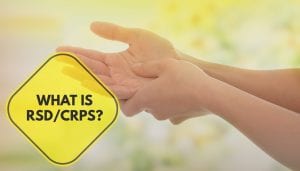What is RSD/CRPS?
Imagine that you’re playing soccer with your local team or you’re out for a hike with friends. Everything is going well until you trip and land on your foot wrong. You’ve twisted your ankle and it ends up being quite sore with a burning sensation for the next few days.
Weeks later, if the pain has not subsided and your ankle and foot is now swelling, changing color and abnormally sweating you are definitely going to be concerned. In addition, if you notice that you are afraid to touch the area out of fear of making symptoms worse, then surely you know that this just can’t be right. One likely explanation of these symptoms is Reflex Sympathetic Dystrophy (RSD), also known as Chronic Regional Pain Syndrome (CRPS). For some reason the sympathetic nervous system, that portion of the nervous system that monitors injury sites, has simply gone nutty. RSD/CRPS almost always begins after an identifiable event such as a crush injury, torn ligament, or fracture, and always results in excessive pain to a stimulus or even hypersensitive pain when there is no stimulus.
RSD Stage 1, 2 and 3
RSD/CRPS has classically been described as presenting in three stages. During Stage 1, sufferers may have symptoms such as:
- Coldness at the injured site
- Sensitivity to cold temperatures
- Sweaty skin
- Color changes in the skin
- Pain with movement
If left untreated, RSD Stage 1 may develop into RSD Stage 2. Stage 2 begins when there is a decrease of local blood flow to the injured site, causing loss of range of motion or even loss of muscle mass. In some cases, if symptoms progress and the injury continues untreated, the bones at the site may thin as well – this is Stage 3.
Less severe forms of weather sensitive pain and sympathetic abnormalities can occur even in the absence of injury. A common example of this is Fibromyalgia. While other weather sensitive pain syndromes do not progress into stages like RSD/CRPS, all sympathetic pain syndromes can be difficult to diagnose. Specialized training and diagnostic equipment such as medical thermal imaging, and an increase in awareness about sympathetic pain can help those with lingering pain after an injury to get treatment.
Why does RSD Occur?
In short, we really don’t know why sympathetic pain syndromes occur. In RSD, the sympathetic nerve is felt to be overacting. Liken it to a car engine that is dieseling: the ignition is off and the key is in your hand, yet the engine is running (but not smoothly). In the case of RSD, the sympathetic nerve stays on and just won’t shut off, even when the injury itself is old and has healed.
Diagnostic studies required for this disorder require a specialist. Most doctors do not know how to recognize the condition and those that do will either perform a sympathetic block (to try to shut down the dieseling) or run specialized testing like medical thermography. However, you have to be careful because failure to respond to a sympathetic block is not really adequate to prove or disprove the diagnosis, and there are still very few medical doctors trained in the proper use of medical thermography.
One of the big problems with using response to sympathetic block as the sole criteria for the diagnosis of RSD/CRPS is that many people suspected of having RSD still complain of pain, even after the block has been implemented. While doctors have a tendency to blame psychological factors when relief does not occur, there are clearly those who still have obvious physical signs of injury, and others who have persisted with their complaints in a consistently reliable manner.
With a specialist, two diagnostic tests can be done to identify the presence of RSD – bone scans and thermography. The bone scan is meant to be more specific, but the thermogram is more sensitive. Thermography measures skin temperature. When a significant, “asymmetric” pattern exists, the test is said to be positive. Although skin temperature is felt to be under the control of the sympathetic nerve fibers, a positive thermogram only means that there is an abnormal physiologic response to injury. It does not tell what the underlying injury was that generated the abnormal sympathetic response.
Determining the source, or generator of that asymmetry, can be a very complex task. If you believe you have a minor or major form of sympathetic pain, it is wise to seek the assistance of a medical doctor with specialized training in RSD/CRPS. Once the type of RSD is diagnosed, and the reasons for its perpetration are discovered, there are many effective non-surgical and non-addicting interventions available that can provide relief.
For RSD/CRPS pain relief, please contact Piedmont Physical Medicine & Rehabilitation here or call us at 864-235-1834.






